#Lü Dongbin
Text
Quien sabe, replica a ello: ¡De ningún modo! El Maestro está inquieto porque el aprendiz todavía no ha colmado su karma, por tal motivo habla así. Ahora, cuando el Trabajo ya ha conducido a las beatíficas campiñas, el corazón es como un espejo de agua. Cuando las cosas vienen, refleja cosas; cuando las cosas se van, se aúnan de por sí otra vez espíritu y fuerza, y no se dejan apartar por las cosas externas. Esto es lo que el Maestro da a entender cuando dice: se ha de renunciar completamente a toda intromisión del pensamiento en otros y en sí mismo.
Cuando el aprendiz consigue acabadamente fijarse al espacio de la fuerza mediante el verdadero pensamiento, no tiene necesidad de poner la Luz en circulación, y la Luz gira por sí misma. Pero cuando la Luz gira, el Elixir se engendra por sí mismo, y nada obstruye que uno lleve simultáneamente a cabo trabajos mundanos. Otra cosa es, en verdad, al comienzo de la meditación, cuando espíritu y fuerza están aún dispersos y confusos.
- Lü Dongbin
0 notes
Text
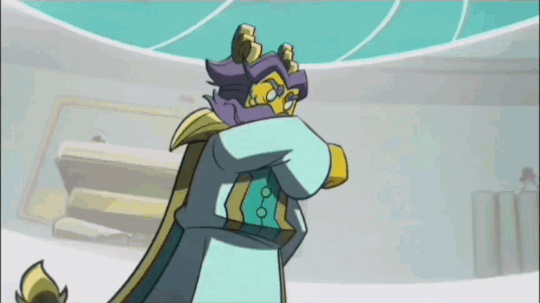
You are a member of the Dragon Clan! Your allegiance is to your family!
Besides Benched and Amnesia Rules, Great Grand Dragon of the East is definitely one of my favorite episodes from S3, but this moment right here is what stuck out to me the most.
And not in a good way.
Joy.
Yeah, this isn't going to be a fun one, folks.
So, because the number varies, we don't actually know exactly how many children Ao Guang has, but because of a proverb that's taken literally in Journey to the West, it's safe to assume he probably has at least nine kids in total. In terms of sons, we do know he has at least three of them. Unfortunately for the Dragon King, all three of those sons also end up dying.
AO BING (敖丙)
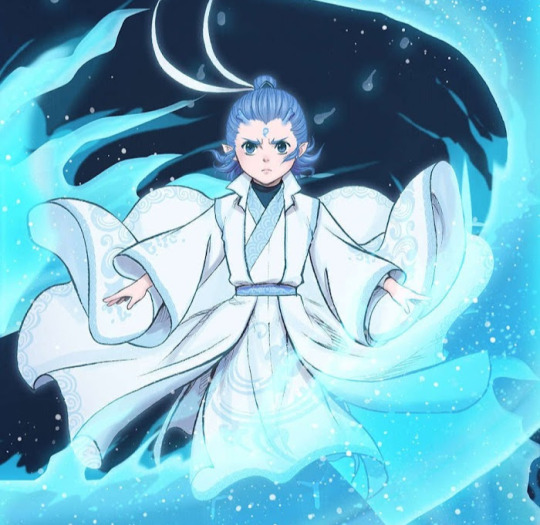
I actually already talked about Ao Bing months ago, but to reiterate, he's the third son of Ao Guang (with his name even referring to the third Heavenly Stem, an ordinal system, when writing it as 丙) and was killed by Nezha after the dragon prince tried to avenge Nezha's other victim Li Gen, who also died trying to attack him after Nezha accidentally disrupted Ao Guang's Crystal Palace by causing a waterquake. After Ao Bing died, Nezha decided to take the dragon's tendon and turn it into a belt.
Keep in mind that Nezha was only seven.
Naturally, Ao Guang was devastated when he learned the news, but Nezha assaulted him before he could report it to the Jade Emperor to keep him quiet. This however didn't stop Ao Guang from trying to take matters into his own hands anyway, so he enlisted the help of his brothers to arrest Nezha's parents for the murders, only for Nezha to sacrifice himself instead.
After the rise of the Zhou Dynasty, Ao Bing eventually gets deified, becoming the god of the Huagai Xing (华盖星), or Imperial Canopy Star.
MOJIE (摩揭) AND LONGDU (龙毒)
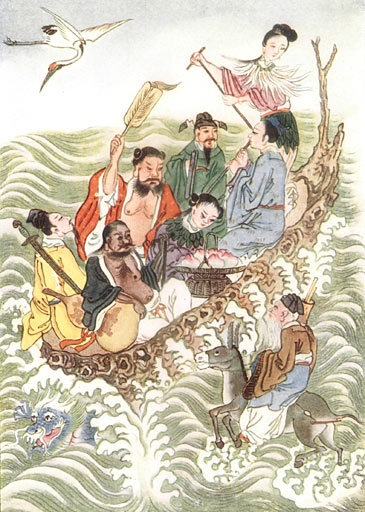
The Eight Immortals Crossing the Sea and one of the dragons who's about to meet his end. Because the only thing worse than losing a child is losing two. On the same day. By the same person.
Enter the Crown Prince and Second Prince, apparently sometimes called Mojie and Longdu respectively.
So, centuries after the Nezha incident, what happened was that a group known as the Eight Immortals decided to cross the East Sea using their powers or magic tools, all while being very drunk. One of them, Lan Caihe (藍采和), decided to do so by using their jade clappers, but this quickly caught the attention of Ao Guang and especially his eldest son due to the clappers shining through the water.
Caihe then ends up getting kidnapped by the Crown Prince so the latter could steal the clappers, and though Ao Guang agrees to give Caihe back after another immortal, Lü Dongbin (呂洞賓), injures his eldest son, he refuses to give the clappers back. This soon leads Lü Dongbin to kill Ao Guang's sons shortly afterwards.
Then it's war.
So the East Sea gets dried up, Ao Guang's palace gets destroyed again, and after Ao Qin convinces his brother to just report this to the Jade Emperor, the two sides are eventually forced to reconcile while Guanyin fixes the Dragon Palace and also gives two pieces of the jade clappers to Ao Guang as compensation.
Side note here, but Sun Wukong himself appears in this story towards the end and it's to side with the Eight Immortals.
And as a sort of honorable mention:
LONGNÜ (龙女)
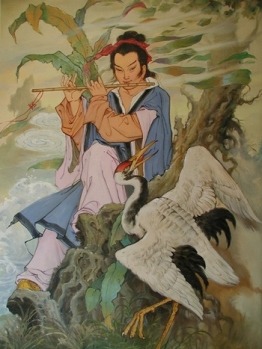
Probably not her actual name, btw; Longnü literally just means Dragon Girl, so it tends to be a pretty common word when referring to a female dragon. But speaking of the Eight Immortals, one of Ao Guang's daughters—prior to the death of her brothers—fell in love with one of them, specifically Han Xiangzi (韓湘子), Lü Dongbin's own apprentice. You know how it goes: boy plays dizi, dragon girl hears it and disguises herself as a silver eel before approaching him... Classic meet cute!
Unfortunately, Ao Guang soon found out about his daughter's affections and forbade her from ever seeing Han Xiangzi again, but she managed to send him a new dizi, one made from Guanyin's own bamboo grove, to remember her by.
167 notes
·
View notes
Text
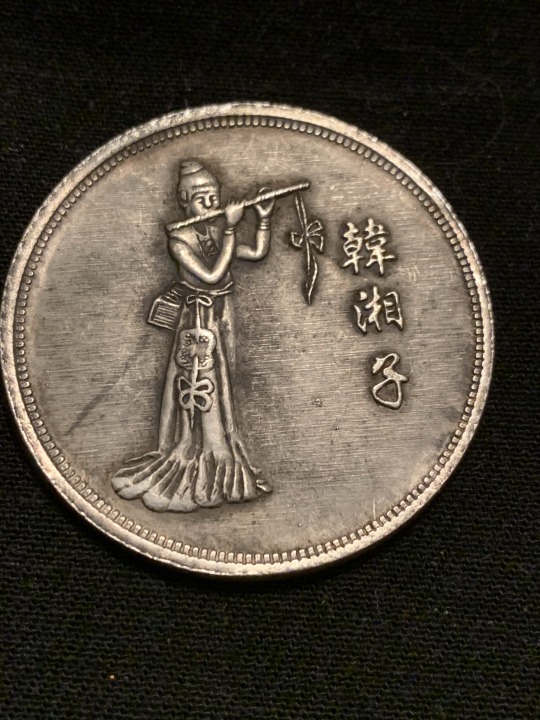
Han Xiangzi, courtesy name Qingfu[1] or Beizhu,[2] is a Chinese mythological figure and one of the Eight Immortals in the Taoist pantheon. He studied Taoist magical arts under the tutelage of Lü Dongbin, another of the Eight Immortals. Han Xiangzi is often depicted carrying a dizi (Chinese flute), so he is also regarded as the patron deity of flutists.[3] He is also believed to be the composer of the Taoist musical piece Tian Hua Yin (天花引).
0 notes
Text
Tales of Taoist Weirdos
As my friends and readers are doubtlessly aware, my spiritual practices are deeply influenced by Taoism. From breathing and energy practices, to philosophical advice, there’s a great deal to learn from the huge body of Taoist writings and lore. However, I’d like to discuss the various personalities of Taoist lore and history.
The greater body of Taoism lore and history contains a number of teachers, alchemists, mystics, and evolved human Immortals. Some are learned sages whose idols adorn temples all over the world. Others are acknowledged once in historical records or the credit of an obscure book. Most of them are just a delightful bunch of weirdos.
Gender-bending beloved flute-player Lan Caihe rubs shoulders with with Lü Dongbin, who achieved immortality after a kind of midlife crisis. There’s an alchemist-Prince who ascended to Heaven accompanies by cats and dogs because he spilled an bottle of immortality drugs. Lao-Tzu, creator of the Tao Te Ching, supposedly wrote his book when he just decided screw this and abandoned the corrupt time he lived in. More common tales might include old men with great physical powers, beggars obsessed with the Tao Te Ching, and more.
I adore this about Taoist lore because of how human is all is. A Taoist figure can be both an admirable role model and a cautionary tale separately or at the same time. Great Immortals come from humble beginnings, often learning from serious mistakes, sometimes with the help of more ancient teachers. Drunken poets spout brilliant prose between bouts of boozing in private groves. Even in more worshipful takes, the great figures of Taoism come off as relatable.
This makes Taoist tales and practices associated them more accessible in my opinion. The figures you encounter, historical and mystical, weren’t perfect in life and might even be eccentric in their divine state. If they can become better, if they can achieve peace or Immortality or just be better folks, so can you.
You also don’t feel judged by these diverse group of mystics and magicians. Their tales aren’t ones of moralizing and finger-wagging, but often of helpful figures who’ve “been there.” They’re not there to punish you – well usually, as some of them are willing to cut serious assholes down to size.
Finally, a lot of the tales of various Taoist figures are interesting and many are outright funny. There’s a reason you’ll see them pop in movies, films, television, etc.
The best way to spiritual practice is through being human – and a sense of humor as well.
- Xenofact
1 note
·
View note
Photo
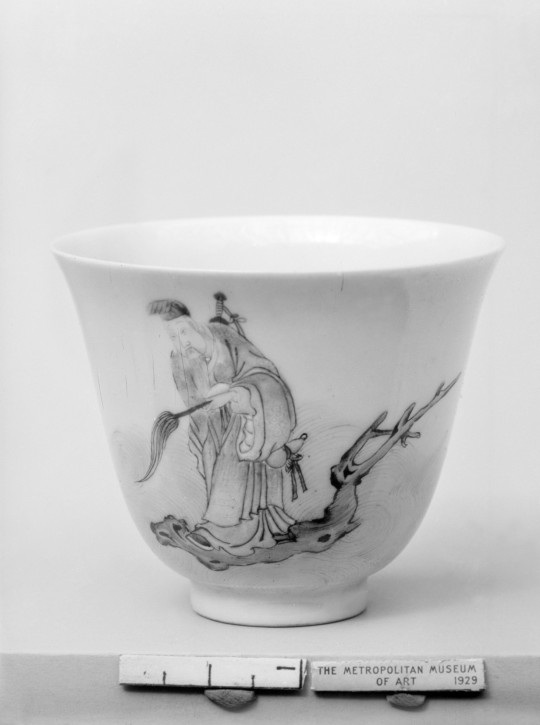
Cup with Lü Dongbin (one of the Eight Immortals). late 18th–early 19th century. Credit line: Edward C. Moore Collection, Bequest of Edward C. Moore, 1891 https://www.metmuseum.org/art/collection/search/46383
#aesthetic#art#abstract art#art museum#art history#The Metropolitan Museum of Art#museum#museum photography#museum aesthetic#dark academia
0 notes
Text
[PDF] Download The Secret of the Golden Flower: A Chinese Book of Life PDF BY Lü Dongbin
Download Or Read PDF The Secret of the Golden Flower: A Chinese Book of Life - Lü Dongbin Free Full Pages Online With Audiobook.
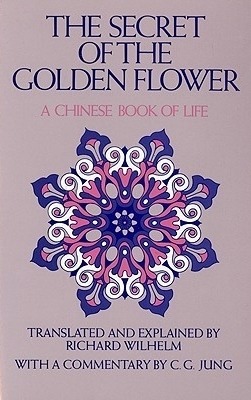
[*] Download PDF Here => The Secret of the Golden Flower: A Chinese Book of Life
[*] Read PDF Here => The Secret of the Golden Flower: A Chinese Book of Life
0 notes
Photo
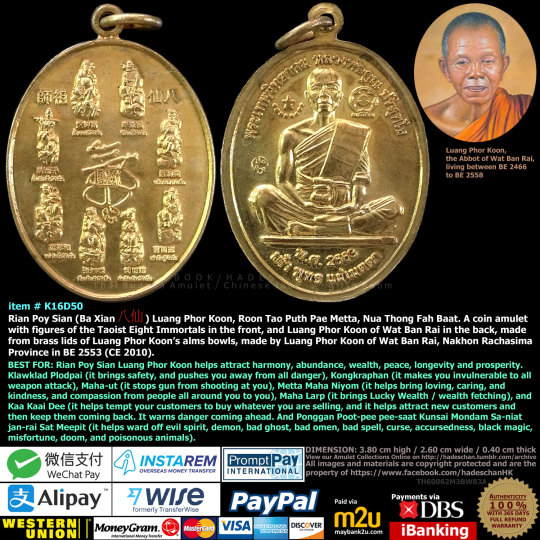
item # K16D50
Rian Poy Sian (Ba Xia八仙) Luang Phor Koon, Roon Tao Puth Pae Metta, Nua Thong Fah Baat. A coin amulet with figures of the Taoist Eight Immortals in the front, and Luang Phor Koon of Wat Ban Rai in the back, made from brass lids of Luang Phor Koon’s alms bowls, made by Luang Phor Koon of Wat Ban Rai, Nakhon Rachasima Province in BE 2553 (CE 2010).
……………………………………………..
The Eight Immortals
The Eight Immortals (Chinese: 八仙; pinyin: Bāxiān; Wade–Giles: Pa¹-hsien¹) are a group of legendary xian ("immortals") in Chinese mythology. Each immortal's power can be transferred to a vessel (法器) that can bestow life or destroy evil. Together, these eight vessels are called the "Covert Eight Immortals" (暗八仙). Most of them are said to have been born in the Tang or Song Dynasty. They are revered by the Taoists and are also a popular element in secular Chinese culture. They are said to live on a group of five islands in the Bohai Sea, which includes Mount Penglai.
The Immortals are:
He Xiangu (何仙姑), in the modern context generally seen as the only female of the group, often depicted holding a lotus flower.
Cao Guojiu (曹國舅), related to a Song dynasty emperor before he became an immortal.
Li Tieguai (李鐵拐), considered to be mentally disturbed and associated with medicine and easing the suffering of the sick and needy, identified by his iron crutch and Calabash bottle.
Lan Caihe (藍采和), originally pictured as female later developed an ambiguous or more accurately, a "transformative" gender and is considered the patron of florists and gardeners.
Lü Dongbin (呂洞賓), a scholar and poet considered to be the leader of the Eight Immortals.
Han Xiangzi (韓湘子), a flute artist.
Zhang Guolao (張果老), a fangshi symbol of longevity.
Zhongli Quan (鍾離權), associated with death and the power to create silver and gold, often depicted holding a fan.
……………………………………………..
BEST FOR: Rian Poy Sian Luang Phor Koon helps attract harmony, abundance, wealth, peace, longevity and prosperity. Klawklad Plodpai (it brings safety, and pushes you away from all danger), Kongkraphan (it makes you invulnerable to all weapon attack), Maha-ut (it stops gun from shooting at you), Metta Maha Niyom (it helps bring loving, caring, and kindness, and compassion from people all around you to you), Maha Larp (it brings Lucky Wealth / wealth fetching), and Kaa Kaai Dee (it helps tempt your customers to buy whatever you are selling, and it helps attract new customers and then keep them coming back. It warns danger coming ahead. And Ponggan Poot-pee pee-saat Kunsai Mondam Sa-niat jan-rai Sat Meepit (it helps ward off evil spirit, demon, bad ghost, bad omen, bad spell, curse, accursedness, black magic, misfortune, doom, and poisonous animals).
……………………………………………..
DIMENSION: 3.80 cm high / 2.60 cm wide / 0.40 cm thick
……………………………………………..
item # K16D50
Price: price upon request, pls PM and/or email us [email protected]
100% GENUINE WITH 365 DAYS FULL REFUND WARRANTY
Item location: Hong Kong, SAR
Ships to: Worldwide
Delivery: Estimated 7 days handling time after receipt of cleared payment. Please allow additional time if international delivery is subject to customs processing.
Shipping: FREE Thailandpost International registered mail. International items may be subject to customs processing and additional charges.
Payments: PayPal / Western Union / MoneyGram /maybank2u.com / DBS iBanking / Wechat Pay / Alipay / INSTAREM / PromptPay International
****************************************
0 notes
Photo

Zhang Lu
Sitting Lü Dongbin, early 16th century
41 notes
·
View notes
Note
So, going back to the Eight Immortals, we know China has quite a few forbidden romance stories already, and one of these includes a member from the group, Han Xiangzi, who trained under Lü Dongbin (yes, the very same Lü Dongbin who would later kill two of Ao Guang's sons) and is regarded as a patron deity of music. While he was still human at this point, his forbidden romance apparently involved falling in love with Ao Guang's seventh daughter, who formed an attraction to him after hearing him play on his dizi. She initially approached him in the form of an eel and showed her true form afterwards.
Somehow, Ao Guang found out about this and forbade her from meeting him ever again, but she made sure to send him a present to remember her by: a bamboo flute made from Guanyin's very own grove.
Though he never forgot her, Xiangzi does end up marrying someone else later on, eventually becomes immortal (in some versions, his wife—if she's even mentioned at all—joins him), and then two of the princess' brothers die at Lü Dongbin's hands centuries later.
—Serenity
Man Ao Guang does not have any luck when it comes to his children
but also SEVEN DAUGHTERS!?
6 notes
·
View notes
Photo


fancast challenge - by @sweetiesplum
#discover | (DAY FOUR) MYTHOLOGY
✨ ba xian, or the eight immortals – more info on the wiki!
✨ chinese legends yay! maybe the most difficult search for fcs i have ever done i think, since i wanted my cast’s features to be a perfect match with the most common depictions of the immortals in arts (reference: here). and i mean, for once, i’ve only chosen actual actors and actresses hahaha gg joyce.
✨ the cast (from top to bottom):
benedict wong as cao guojiu
chow yun fat as li tieguai
xing en as lan caihe
yang mi as he xiangu
donnie yen as lü dongbin
tom wu as han xiangzi
shen baoping as zhang guolao
tzi ma as zhongli quan
❀ made by/credits: kawaiinekoj (instagram | linktree)
#kawaiinekoj#fancastchallenge#challenge#discover#ba xian#chinese mythology#myths and legends#mythedit#mythology#the eight immortals#benedict wong#chow yun fat#xing en#yang mi#donnie yen#tom wu#shen baoping#tzi ma#collage#underused fc#fancast#academia#vintage#lunar new year
8 notes
·
View notes
Photo

Old Man of the Southern Pole (under tree), Lü Dongbin (left), Zonglin Quan (center), Xue Shenwong (right) [center left of the set Daoist Immortals], Kano Sansetsu, 1646, Minneapolis Institute of Art: Japanese and Korean Art
Set of four sliding door panels with decoration of Chinese Immortals These sliding door panels (fusuma) show a group of Chinese Daoist immortals. The Chinese believed the immortals were historical and legendary personages who, through moral virtue, faith, and discipline, managed to transcend the bounds of the natural world and live forever. They were worshiped as saints. Old Chinese themes like this were admired in Japan by military rulers and Zen priests, who exalted Chinese culture and its heroes. This set of panels formed part of a much larger suite of paintings made for a temple in Kyoto. In the 1640s, Kano Sansetsu and his studio created hundreds of panel paintings for this temple. A devastating fire in the 1800s destroyed all but eight—the four panels you see here and four paintings that decorated their reverse, now in the Metropolitan Museum of Art in New York.
Size: 65 1/2 x 45 1/2 in. (166.37 x 115.57 cm) (image) 69 x 49 x 1 3/4 in. (175.26 x 124.46 x 4.45 cm) (outer frame)
Medium: Ink, color, and gold leaf on paper
https://collections.artsmia.org/art/18574/
11 notes
·
View notes
Photo

Door Lintel Ornament: "Hanging Cash" with Han Xiangzi and Lü Dongbin, Two of the Eight Immortals, early 20th century, Harvard Art Museums: Prints
Harvard Art Museums/Arthur M. Sackler Museum, Gift of Langdon Warner
Size: paper: 55.7 x 23.2 cm (21 15/16 x 9 1/8 in.)
Medium: Collage of printed and cut paper elements: red "paper-cut" decoration with applique woodblock printed image; ink and color on paper. Probably from Beijing; identical to 1935.36.126.6.
https://www.harvardartmuseums.org/collections/object/16891
6 notes
·
View notes
Text
Daoist transcendental meditation in “Light of the Eyelid”

(Hi and welcome! This should be my last long, involved post for a while—gotta get back to work after Christmas break—but a couple of shorter ones are in the works for later.)
Introduction: Daoist meditation and the motion of return
Returning is the motion of the Dao
Yielding is the way of the Dao.
The ten thousand things arise from being.
Being arises from not being.
—Dao De Jing #40
(pg. 43)
Of all the Mushishi stories to feature kouki (光酒, “light saké”) and the river of light, this one perhaps offers the most clues to their possible origins in Daoism, and specifically in Daoist transcendental meditation practices—which, it turns out, are quite dangerous, done improperly.
In “Light of the Eyelid,” Ginko communicates across the river of light with a little girl, Sui, who is several days’ travel away. Both reach this transcendental state by closing their “second eyelids,” retreating to a realm of absolute darkness, wherein the river of light appears. This river we know to be a vein of kouki, the essence of life itself and the source of vitality in the physical world.
The connections to Daoism here are many, beginning with the idea of “return to the source,” which appears throughout the Dao De Jing and is the foundation of many Daoist meditation practices. Dao De Jing verse #16 is often taken as a description of meditation:
Empty yourself of everything.
Let the mind become still.
The ten thousand things rise and fall while the self watches their return.
They grow and flourish and then return to the source. (pg. 18)
In Daoist cosmology, life emerges from the un-manifest, or what in the first verse of the Dao De Jing is called “darkness within darkness” (pg. 3). This is yin, the “primal female,” and the source to which Daoist meditation aims to reconnect.
That the “true darkness” and the river of light in “Light of the Eyelid” refer to the origin of life is unambiguous. Ginko says that Biki has watched the river too, in a time before his memory, and earthly life flourishes where the river flows. The episode’s references to a distant past when it was common to see the river of light also echo the many references in the Dao De Jing and in Zhuangzi to the people of old and their closeness to life’s source. From Zhuangzi’s Inner Chapters:
“Among the ancients, knowledge was very deep. What is meant by deep? It reached back to the time when nothing existed.” (tr. Feng and English, pg. 30)
Ginko and Sui’s retreat to the darkness through which life flows is thus easily connected to the Daoist “return to the source” of life.
The Way of the Light Saké
I won’t attempt here to outline the wild and crazy history of the Daoist alchemical/meditative practice called “The Way of the Golden Elixir.” This paper is comprehensive and will be linked many times below. Fortunately, the interpretation I believe Urushibara-sensei to be drawing on in Mushishi is the most fundamental: The “golden elixir” is the essence of life itself, accessible via a “return to emptiness” (pg. 51). This is the approach that directly links “Golden Elixir” practice with the “return” of the Dao De Jing (pg. 46). This process is
“frequently illustrated through the metaphor of the creation of ‘a person outside one’s person’ (or ‘a self outside oneself,’ shen zhi wai shen), which represents the attainment of transcendence and is defined as the ‘true person’... (pg. 52)
Ginko and Sui can be seen as performing just this kind of transcendental meditation, manifesting themselves outside their bodies into the “true darkness” of the source and alongside the river of the essence of life.
True Yin and True Yang
The “true darkness” and “alien light” of the state through which Ginko and Sui communicate can also be linked to this form of meditation. Golden Elixir practice seeks, in various ways, the unity of the primordial True Yang and True Yin (pg. 25)—that is, the two primal forces, represented as light and darkness respectively, that exist beneath all manifest things (the world of yin and yang we perceive). The pure darkness and strange light of the light flow can be seen as analogous to this True primordial Yin and Yang—especially given Ginko’s words in S1 E19 “Thread from the Sky,” in which he describes the mushi as “lying on the border with yang.” This boundary between primordial light and darkness is, as Sui says, where the mushi live.
Seeing this connection in “Light of the Eyelid,” we can understand kouki as a reference to the “golden elixir”—which can be either an internal force or an external substance, and which, in various uses, can also heal illnesses or even confer immortality (pg. 4), as a seed “containing the light flow” does in Mushishi S1 E9 “The Heavy Seed.”
Kouki (光酒, “light saké”) could also, if we like, be taken as a play on words and a reference to yuanqi (元氣), or the “Original Pneuma” propagated “into the ‘ten thousand things’”— a Daoist term meaning “everything that exists”—and concentrated in Golden Elixir practices (source).
So what happened to poor Sui?
This sort of transcendental meditation is no game. Warnings abound (pg. 49) about practicing it incorrectly, and the writings of Lü Dongbin, one of its founders, are especially suggestive. If, he says, a practitioner is able to free “the form of an infant resembling oneself” to “travel through the universe... unhindered through the ten directions,” but at the same time does not know the dao, they are at risk of being beset by a “sharp, cutting, and piercing [wind that] enters through the forehead...” If this wind does not destroy them, the next danger is “a poisonous fire, which rises from below and enters through the top of the head, attacking the internal organs... The pores and the hairline are instantly turned into ashes” (source, pgs. 80–81).
In “Light of the Eyelid,” Sui first suffers stabbing pain in her eyes when exposed to daylight and then, after walking into the river of light (”fire from below”), from her eyeballs disintegrating into a powdery, smoking blackness. Given the warnings above, she might be said to have gotten off easy—although somehow surviving these trials is acknowledged to be possible. (pg. 81)

Ouch.
As she does with other lore, Urushibara-sensei traces the origins of these warnings to mushi, in this case to a nasty-looking scorpion-snake, manakonoyami-mushi, that infects eyeballs too long exposed to darkness and the river of light.
The danger of emotions
Why did this happen? Lü Dongbin warns that the afflictions he describes come from practicing transcendence without keeping to the dao. As he emphasizes, a critical part of this is maintaining emotional control.
Emotional detachment is no small part of Daoist practice. This mindset is described by Zhuangzi as wuqing—literally “without feelings,” but actually meaning that one is not dominated by desires or preferences (Hall and Ames pg. 47). Ginko demonstrates a capacity for this kind of control: While he routinely expresses mild irritation, when something truly distressing happens, he’s... still only mildly irritated. See, e.g., S1 E21 “Cotton Changeling,” when he gets freaking stabbed and not only barely reacts, but shows no subsequent resentment whatsoever.
Not only is this preternatural emotional stability characteristically Daoist, it’s essential for transcendental meditation. Lü Dongbin is aggressive about the danger of emotions and the need to remove them from the root, likening them to “parasites”:
If you try to control emotions forcibly without extirpating the root [desire], you control nothing but outgrowths. This is like a flood of water: if you try to dam it without stopping the source or clearing the flow, eventually you’ll be drowned. It is also like a blazing fire: if you try to beat it out without removing its fuel or cutting off its path, you’ll just increase the force of the flames, so that you’ll be threatened at every turn.” (pgs. 90–91)
Only when the mind is free of “defilement and attachment” is one able to “crystallize the great elixir” in a transcendental state. This is not to be attempted without guidance in the dao (pgs. 88–89) to ensure the stability needed to avoid danger.
We can see the dangers of emotions, and specifically of desire, affecting Sui from the start. The river of light’s attraction is strong—she has to be warned away from its shore repeatedly, and Biki, after even a brief glimpse, wants to stare at it forever. Because she’s so drawn to it, Sui fails to moderate the time she spends looking at it, and thus becomes infected by the manakonoyami-mushi. This is bad enough—but it’s her grief over Biki’s illness that prompts her to do what Ginko repeatedly warned her not to: walk into the “poisonous fire” of the river of light, resulting in her infected eyes being reduced to ash.
As Lü Dongbin warns, desires and attachments are indeed dangerous.
Last notes
So, we can trace much of what we see in "Light of the Eyelid” to the concepts and lore of Daoist meditative practices. But at the root of all this, we simply find one of the major ideas seen throughout Mushishi. The incompatibility between “return to the source” and the emotional bonds and complexities of the modern human is one of the series’ many explorations of the conflict and the search for harmony between human beings and the “way of nature.”
Ginko personifies a hope that such harmony is possible—he’s neither devoid of emotions nor prey to them, neither indifferent to Sui and Biki’s suffering nor incompatible with the river of light.
Though given how many times he saw Sui across the river, it’s possible he just wanted to be able to meditate in peace.
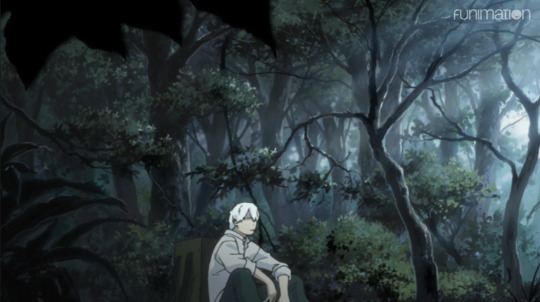
22 notes
·
View notes
Photo
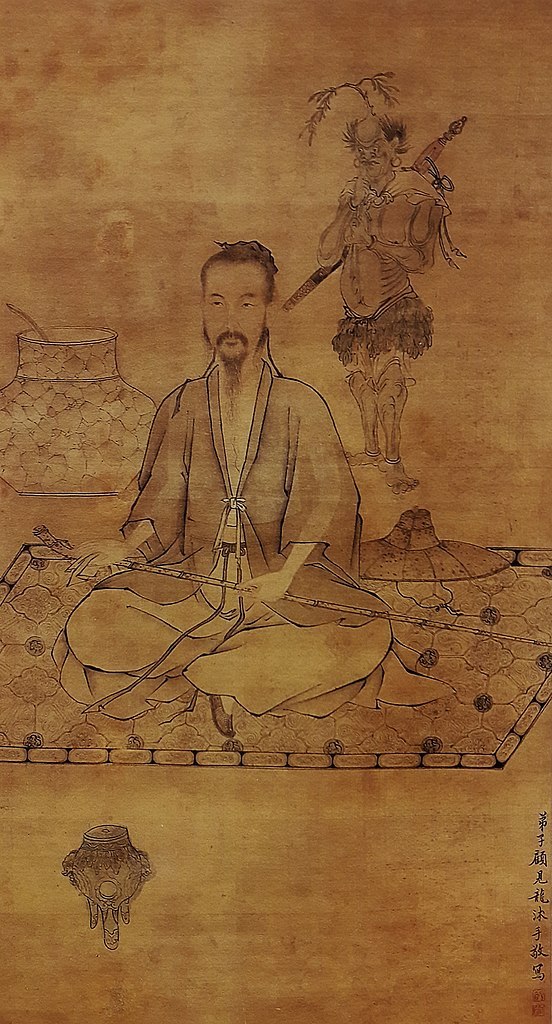
Gu Jianlong's Painting of Immortal Lü Dongbin
Can't see too much of his jian, but as typical for the period, note the open pommel.
4 notes
·
View notes
Note
Hey there, Antidote. I'm not trans, but as a Chinese girl that comic hit me in the feels because of the transphobia and the other stuff. I have a small question, and that is: What do you think of the rest of the Eight Immortals (Zhangguolao, Hexiangu, Lüdongbin...)?
Honestly as a kid I wasn’t as interested in the Eight Immortals as I was in Nezha or other figures, but I thought they were cool! It was funny to see them hanging out with Sun Wukong in TVB’s Journey to the West.
I think my favorite was Lü Dongbin because I always thought the drunken immortal trope was pretty cool and I think I also liked He Xiangu because Cantonese representtttt
12 notes
·
View notes
Video
youtube
My Candy Love Valentine's Day Event 2020 Priya is online!
Guide for Priya
Day 1:
A. (I picked the bouquet of cinquefoll, I love the color of these little yellow flowers.)
B. (I picked the bouquet of jasmine, the scent is mesmerizing.) Correct answer
C. (I picked the bouquet of daffodils, I love how these flowers grow one-by-one.)
A. (I chose the card showing a god with an impressive stature, wielding a sword … His name is written on the card: Lü Dongbin”.)
B. (I chose the card that shows a god holding a balance in his hand. His name is written on the card: “Lu Hsing”) Correct answer
C. (I chose the card that showed a hunchbacked god watching over two people on the ground, his name is written on the card: “Tieguai Li”.)
A. (I chose the number 2.)
B. (I chose the number 6.) Correct answer
C. (I chose the number 5.)
A. (I chose the tiger’s eye. The circles remind of rings in a cut tree trunk.)
B. (I chose the orange carnelian. I was attracted by its autumnal color.) Correct answer
C. (I chose the fragment of blue lapis-laruli. It’s rare to see this stone, it can be expensive…)
Day 2:
A. (I chose Empress, card number 3.) Correct answer
B. (I chose the Lovers, card number 6.)
C. (I chose the Judgement, card number 20.)
A. (I chose Sowilo, rune number 16) Correct answer
B. (I chose Ingwaz, rune number 12)
C. (I chose Ehwaz, rune number 19)
A. The Otter…
B. The Falcon… Correct answer
C. The Bear…
A. What will happen next, between Priya and me? Correct answer
B. Will Priya do well in this law firm…?
C. Will Priya pass her bar exam?

19 notes
·
View notes